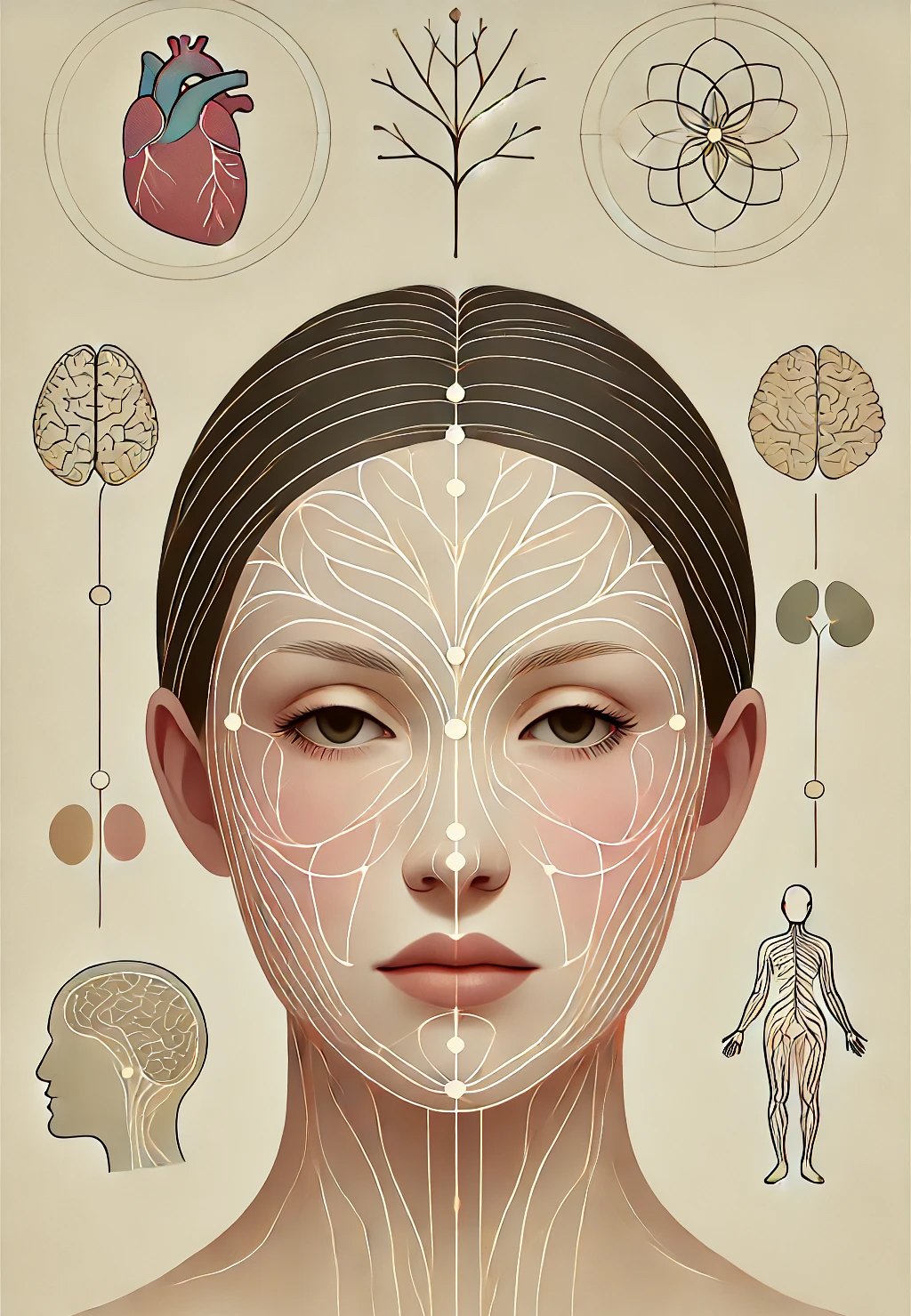NeuroCosmetics – Integrated Aesthetics, Healing and Relaxation
Neurocaris™/ Neurocutea™: Integrative Neurocosmesis™ — Lynnea Villanova MD, in collaboration with Skin Solutions Collective
I. Theoretical Foundation
Integrative Neurocosmesis™ proposes a unified framework linking the brain–skin axis, emotional regulation, and aesthetic medicine.
Drawing upon Traditional Chinese Medicine (TCM) principles of systemic harmony and modern neuroscience, this model recognizes the face as both a diagnostic surface and a neurological interface reflecting internal adaptation.
Historically, TCM associated facial zones with organ systems: the Liver with emotional regulation, Lungs with grief, Heart with joy and vitality, and Kidneys with willpower and resilience (Bridges, 2012). In this model, visible aging is not degeneration but energetic transcription—the body’s record of experience.
Modern psychodermatology echoes this insight: the skin and brain originate from the same embryologic tissue (ectoderm) and maintain constant dialogue through hormonal, immune, and neural pathways (Roosterman et al., 2006).
II. Neurocutaneous and Neuroendocrine Pathways
Stress activates the HPA (hypothalamic-pituitary axis), elevating cortisol and impairing barrier repair mechanisms (Choe et al., 2018).
Cutaneous afferents transmit emotional and sensory information to the brainstem, hypothalamus, and limbic system, influencing emotion, immunity, and vascular tone.
Conversely, interventions such as acupuncture, gua sha, temperature contrast, and neuromodulation can induce parasympathetic dominance and vagal activation, measurable via heart rate variability and cortisol reduction (Napadow et al., 2020; Guo et al., 2022).
Acupuncture points like Yin Tang and Shen Men are known to regulate amygdala and hypothalamic activity, linking emotional calm to improved dermal function (Finzi & Rosenthal, 2014). This dual somatic–emotional effect underscores the shen–neural connection long described in Chinese medicine.
III. Neuroplasticity and Emotional Regulation
Emotional regulation is a trainable neural capacity. Changes in facial expression and sensory feedback can directly alter limbic reactivity—demonstrated in studies where Botox-mediated muscle relaxation reduced amygdala activation and improved mood (Hennenlotter et al., 2009; Nestor et al. 2025).
This supports the hypothesis that aesthetic and sensory interventions influence neuroplasticity and emotional state through facial afferent pathways.
IV. Neurocosmetics and Neurocuticals
Neurocosmetic research explores cutaneously active compounds that engage the skin–brain axis.
Ingredients such as neuropeptides, β-endorphin analogs, and dopaminergic or serotonergic actives stimulate cutaneous nerve endings and mood-related receptors (Dobos, 2024; Scholzen, 2006).
Adaptogenic neurocuticals drawn from TCM—ginseng, licorice, schisandra, Ziziphus —modulate oxidative stress, inflammation, and HPA reactivity, while harmonizing qi and stabilizing shen.
Together, these agents demonstrate that the face can be treated as a neuroendocrine and emotional organ, not just a cosmetic surface.
V.Applications In Aesthetic Medicine
Integrative Neurocosmesis™ extends beyond skincare. When combined with acupuncture, vagal stimulation, or non-invasive neuromodulation, it promotes autonomic balance, enhances post-procedural recovery, and supports emotional well-being—an emerging priority in aesthetic medicine (Dreno et al., 2025).
Incorporating these therapies allows aesthetics practices to bridge wellness and clinical neuroscience,offering patients visible rejuvenation options alongside nervous system recalibration.
References
A warm and generous provider, Dr Villanova enjoys applying her insights and experience in allopathy, medical acupuncture, Chinese herbal medicine and Ayurveda to integrate biological, emotional, social and spiritual aspects of individual and group healing/understanding. Dr Villanova is board certified in Family Medicine and Medical Acupuncture.
When not working with patients, she conceives, writes and executes music, theatre and film productions in New York City, and is a published essayist and poet. Currently, her multimodal theater work at the nexus of neuromodulation and healing is in production in NYC and heading for Europe
Dr Villanova’s full medical website here

